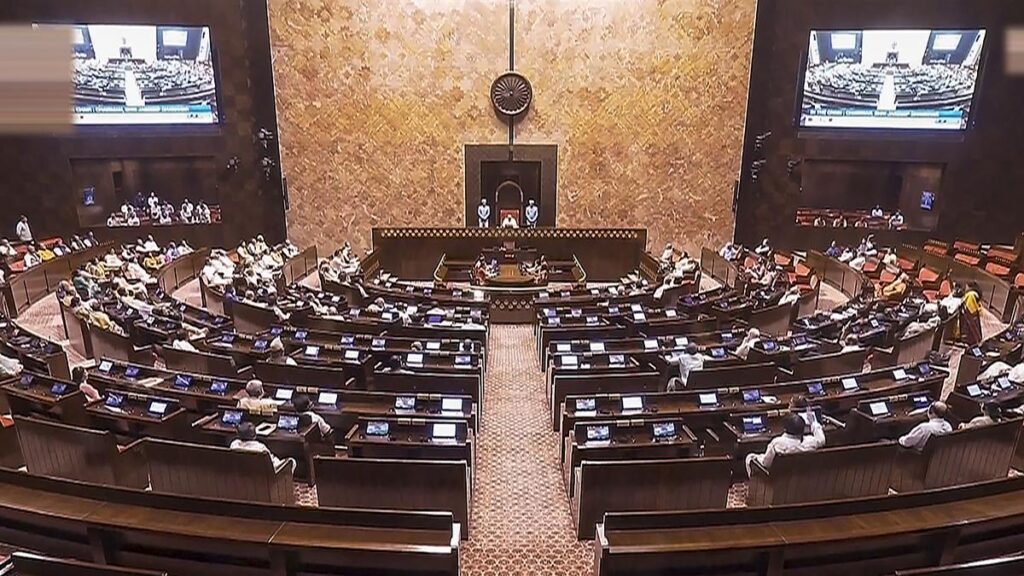
Rajya Sabha in session. File photo
Contests for biennial elections to the Rajya Sabha have, of late, become uncommon in Tamil Nadu. But they were an integral part of the poll process on many occasions, almost from the beginning.
In March 1956, eight months before the re-organisation of southern States, 10 candidates were in the fray for six seats. The ruling Congress fielded four including V.K. Krishna Menon, who was Union Minister without portfolio and the Communist Party of India (CPI), P. Narayana Nair. There were five independents who included A. Ramaswami Mudaliar, one of the early members of the Justice Party. Only Menon and Nair were declared elected in the first count, as they got more votes than the requisite number of 31.58 votes. Mudaliar, who got only 22 votes initially, was the only independent candidate to emerge successfully in the second count, according to a perusal of reports published by The Hindu in March 1956.
In March 1964, the ruling Congress fielded veteran journalist-film producer-director S.S.Vasan, and four others while the Muslim League and Swatantara had one each. Interestingly, the fifth candidate of the Congress and former president of the Tamil Nadu Congress Committee, K. Rajaram Naidu, lost while all others won. Two years later, the Congress had to face the same experience of having one of its nominees – P. Ramachandran (who later became Union Minister in the Janata government during 1977-79) – biting the dust. The Swatantara and the Dravida Munnetra Kazhagam (DMK) succeeded in sending one each of theirs to the Upper House.
In March 1968, when the DMK had a comfortable majority in the State Assembly, it had sent two members to the Rajya Sabha. Its allies during the 1967 Assembly election, CPI (Marxist), Muslim League and the Swatantara, got one member each. The remaining one seat went to the Congress, which was the principal Opposition party in the Assembly. One of the outgoing members of the Upper House J. Sivashanmugam Pillai chose to enter the fray as an independent as his party – the Congress – had nominated only one candidate (K.S. Ramaswamy). Pillai had lost miserably, polling 12 votes.
But it was in 1970 that the State witnessed one of the closely-watched electoral contests, because of C. Subramaniam, who was preferred by the then Prime Minister Indira Gandhi to be in Parliament at the earliest on account of his defeat in Gobichettipalayam in the 1967 Lok Sabha election. By then, there were two Congress parties at the all India level – Congress (Organisation) that had K. Kamaraj, S. Nijalingappa and Morarji Desai as key faces and Congress (Ruling) that comprised personalities including Jagjivan Ram and Indira Gandhi. Subramaniam, CS as he was known, was with the second group, which was weaker in the Tamil Nadu Assembly and had eight MLAs in the Assembly. The ruling DMK, which had got all the three nominees elected to the Upper House, had decided not to support Subramaniam while the Congress (O) had asked its legislators to cast their second preference votes in support of the Swatantara, which had even otherwise been assured of surplus votes from the DMK. Eventually, CS lost, by polling 23 votes, way behind the requisite quota. One nominee each from the Congress (O), Swatantra and the Muslim League romped home.
In July 1983, the CPI (M) stalwart, P. Ramamurti, suffered the setback, as he polled only 26 votes against the required 32.72 votes. In the fray, he and the Congress leader G.K. Moopanar competed for the sixth slot. Though the surplus votes of the DMK were transferred to the Marxist leader, he could not get in. In June 1986, the DMK’s T. R. Baalu, who was the then Madras District Secretary of the party, surprised everyone by securing 35 votes in the first round even though his party had 22 MLAs. The DMK, at best, had hoped to get 31 votes with the support of its allies – CPI, CPI(M) and the Muslim League, totalling nine members. But four votes had apparently gone from the then AIADMK-Congress front. The loser then was the Janata Party’s Era Sezhiyan, a seasoned parliamentarian, who was also supported by the AIADMK. Ten years later, though S. Peter Alphonse of the Congress had won comfortably, he faced a contest from his erstwhile colleague, Udaya Bhanu.
Later, Kanimozhi Karunanidhi of the DMK and Desiya Murpokku Dravida Kazhagam (DMDK) A.R. Elangovan fought for the sixth seat, while it was clear from the start that the remaining five seats would go to the AIADMK and its ally, CPI. The support from the Congress and a couple of other smaller parties ensured Kanimozhi’s victory, even though DMDK founder Vijayakant had accused the AIADMK of indirectly helping the DMK candidate win the seat.
Published – May 28, 2025 09:24 pm IST
Source:https://www.thehindu.com/news/national/tamil-nadu/when-rajya-sabha-elections-in-tamil-nadu-faced-contests/article69630231.ece

